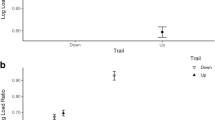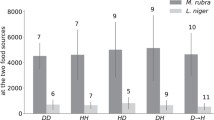Abstract
Central-place foraging theory has been unable to explain the load selection behavior of leaf-cutting ants (Atta spp., Attini: Formicidae). We suggest that this is due to incomplete consideration of the sequence of behaviors involved in resource acquisition by these ants. Unlike most central-place foragers, leaf-cutting ants do not return to their nests with food. Instead, the leaf fragments they gather must be processed within the nest to convert them to substrate for fungal gardens. We have shown previously that leaf fragment size affects the rate of distribution and processing of leaf tissue inside laboratory nests of Atta colombica. Including these tasks in the calculation of foraging rate may help explain load selection and other features of central-place foraging by Atta colonies. Here we develop a mathematical model of the complete sequence of external and internal tasks that lead to addition of substrate to fungal gardens. Using realistic parameter values, the leaf fragment sizes predicted to maximize a colony's rate of foraging in this broad sense correspond well with the mean fragment sizes actually collected by Atta colonies in the field. The optimal fragment size for global performance in the model is below the size that would maximize the delivery rate by above-ground foragers. The globally optimal size also fails to maximize the rate of either fragment distribution or fragment processing within the nest. Our results show how maximum collective performance of an ensemble of linked tasks may require behavior that would appear suboptimal in a piecemeal analysis of tasks.


Similar content being viewed by others
References
Anderson C, Jadin JLV (2002) The adaptive benefit of leaf transfer in Atta colombica. Insectes Soc 48:404–405
Anderson C, Ratnieks FLW (1999) Task partitioning in insect societies. I. Effect of colony size on queueing delay and colony ergonomic efficiency. Am Nat 154:521–535
Bass M, Cherrett JM (1996) Leaf-cutting ants (Formicidae, Attini) prune their fungus to increase and direct its productivity. Funct Ecol 10:55–61
Burd M (1995) Variable load size–ant size matching in leaf-cutting ants, Atta colombica (Hymenoptera: Formicidae). J Insect Behav 8:715–722
Burd M (1996a) Foraging performance by Atta colombica, a leaf-cutting ant. Am Nat 148:597–612
Burd M (1996b) Server system and queuing models of leaf harvesting by leaf-cutting ants. Am Nat 148:613–629
Burd M (2000a) Foraging behaviour of Atta cephalotes (leaf-cutting ants): an examination of two predictions for load selection. Anim Behav 60:781–788
Burd M (2000b) Body size effects on locomotion and load carriage in the highly polymorphic leaf-cutting ants Atta colombica and Atta cephalotes. Behav Ecol 11:125–131
Burd M (2001) Leaf tissue transport as a function of loading ratio in the leaf-cutting ant Atta cephalotes. Ecol Entomol 26:551–556
Burd M, Aranwela N (2003) Head-on encounter rates and walking speed of foragers in leaf-cutting ant traffic. Insectes Soc 50:3–8
Burd M, Howard JJ (2005) Central-place foraging continues beyond the nest entrance: the underground performance of leaf-cutting ants. Anim Behav (in press)
Howard JJ (1991) Resource quality and cost in the foraging of leaf-cutter ants. In: Huxley C, Cutler D (eds) Ant-plant interactions. Oxford University Press, Oxford, pp 42–50
Jeanne RL (1986) The organization of work in Polybia occidentalis: costs and benefits of specialization in social wasp. Behav Ecol Sociobiol 19:333–341
Jeanne RL (1999) Group size, productivity, and information flow in social wasps. In: Detrain C, Deneubourg JL, Pasteels JM (eds) Information processing in social insects. Birkhäuser, Basel, Switzerland, pp 3–30
Kacelnik A (1993) Leaf-cutting ants tease optimal foraging theorists. Trends Ecol Evol 8:346–348
Kleineidam C, Tautz J (1996) Perception of carbon dioxide and other “air-condition” parameters in the leaf cutting ant Atta cephalotes. Naturwissenschaften 83:566–568
Kleineidam C, Roces F (2000) Carbon dioxide concentrations and nest ventilation in nest of the leaf-cutting ant Atta vollenweideri. Insectes Soc 47:241–248
Lighton JRB, Bartholomew GA, Feener DH (1987) Energetics of locomotion and load carriage and a model of the energy cost of foraging in the leaf-cutting ant Atta colombica Guer. Physiol Zool 60:524–537
Lutz F (1929) Observations on leaf-cutting ants. Am Mus Novit 388:1–21
Mueller UG, Rehner SA, Schultz TR (1998) The evolution of agriculture in ants. Science 281:2034–2038
Ratnieks FLW, Anderson C (1999a) Task partitioning in insect societies. Insectes Soc 46:95–108
Ratnieks FLW, Anderson C (1999b) Task partitioning in insect societies. II. Use of queueing delay information in recruitment. Am Nat 154:536–548
Roces F (1990) Leaf-cutting ants cut fragment sizes in relation to distance from the nest. Anim Behav 40:1181–1183
Roces F, Nuñéz JA (1993) Information about food quality influences load-size selection in recruited leaf-cutting ants. Anim Behav 45:135–143
Röschard J, Roces F (2002) The effect of load length, width and mass on transport rate in the grass-cutting ant Atta vollenweideri. Oecologia 131:319–324
Rudolph SG, Loudon C (1986) Load size selection by foraging leaf-cutter ants (Atta cephalotes). Ecol Entomol 11:401–410
Seeley TD, Tovey CA (1994) Why search time to find a food-storer bee acurately indicates the relatives rates of nectar collecting and nectar processing in honey bee colonies. Anim Behav 47:311–316
Shutler D, Mullie A (1991) Size-related foraging behaviour of the leaf cutting ant Atta colombica. Can J Zool 69:1530–1533
Stephens DW, Krebs JR (1986) Foraging theory. Princeton University Press, Princeton
van Breda JM, Stradling DJ (1994) Mechanisms affecting load size determination in Atta cephalotes L. (Hymenoptera, Formicidae). Insectes Soc 41:423–434
Weber NA (1966) Fungus-growing ants. Science 153:587–604
Weber NA (1972) Gardening ants: the attines. American Philosophical Society, Philadelphia
Wetterer JK (1989) Central place foraging theory – when load size affects travel time. Theor Pop Biol 36:267–280
Wetterer JK (1991) Source distance has no effect on load size in the leaf-cutting ant, Atta cepahlotes. Psyche 98:355–359
Wetterer JK (1994a) Forager polymorphism, size-matching, and load delivery in the leaf-cutting ant, Atta cephalotes. Ecol Entomol 19:57–64
Wetterer JK (1994b) Ontogenetic changes in forager polymorphism and foraging ecology in the leaf-cutting ant Atta cephalotes. Oecologia 98:235–238
Wilson EO (1980) Caste and division of labor in leaf-cutter ants (Hymenoptera: Formicidae: Atta) II. The ergonomic optimization of leaf cutting. Behav Ecol Sociobiol 7:157–165
Wilson EO (1983) Caste and division of labor in leaf-cutter ants (Hymenoptera: Formicidae: Atta) IV. Colony ontogeny of Atta cephalotes. Behav Ecol Sociobiol 14:55–60
Wirth R, Herz H, Ryel RJ, Beyschlag W, Hölldobler B (2003) Herbivory of leaf-cutting ants: a case study on Atta colombica in the tropical rainforest of Panama. Springer, Berlin
Acknowledgments
We thank Alan Lill and the anonymous reviewers for comments that have helped to clarify the presentation. MB thanks J.-L. Deneubourg and the Centre pour l'Etude des Phénomènes Nonlinéaires at the Université Libre de Bruxelles for their hospitality during a sabbatical leave when the model was completed. We owe the ‘distributed cow’ analogy to Nuvan Aranwela; this casual remark was the impetus for us to consider ‘sociodigestion’ of substrate within Atta nests. Financial support for this work was provided by an Outside Studies Program grant from Monash University to MB and by the Louisiana Board of Regents Support Fund to JJH
Author information
Authors and Affiliations
Corresponding author
Additional information
Communicated by L. Sundström
Rights and permissions
About this article
Cite this article
Burd, M., Howard, J.J. Global optimization from suboptimal parts: foraging sensu lato by leaf-cutting ants. Behav Ecol Sociobiol 59, 234–242 (2005). https://doi.org/10.1007/s00265-005-0029-4
Received:
Revised:
Accepted:
Published:
Issue Date:
DOI: https://doi.org/10.1007/s00265-005-0029-4




